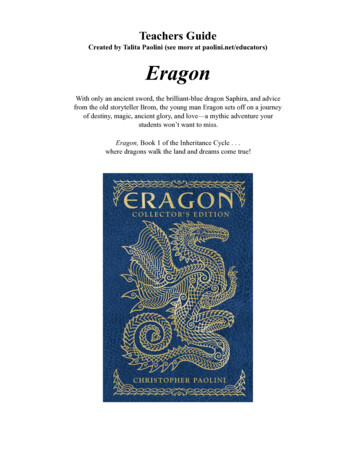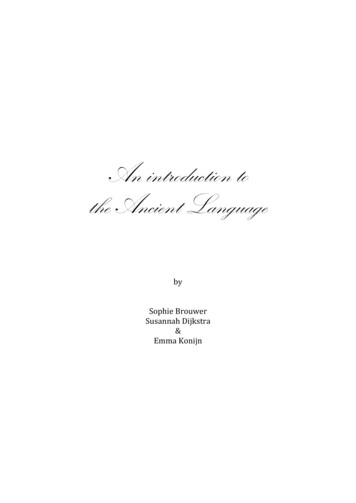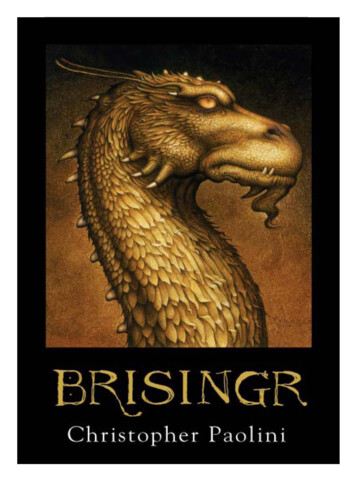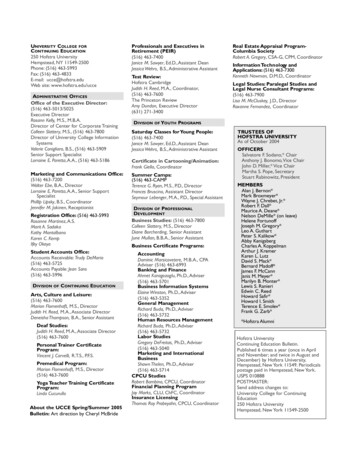
Transcription
Teachers GuideCreated by Talita Paolini (see more at paolini.net/educators)EragonWith only an ancient sword, the brilliant-blue dragon Saphira, and advicefrom the old storyteller Brom, the young man Eragon sets off on a journeyof destiny, magic, ancient glory, and love—a mythic adventure yourstudents won’t want to miss.Eragon, Book 1 of the Inheritance Cycle . . .where dragons walk the land and dreams come true!
For the ClassroomGet ready to study Eragon with these exciting projects!Create the Mood: Decorate your classroom door with images of the dragon book cover,dragon eggs, fanciful swords, an elven forest, etc.Follow Eragon: Draw (or have a student draw) a large map of Alagaësia and attach it toa wall. Trace Eragon’s journey on the map as you progress through the 6/06/MapAlagaesiaPrintOut.pdfCharacter Posters: On the day you introduce Eragon, put up posters for the maincharacters. Example: Eragon, Saphira, Arya, Brom, Joed, Angela, Roran, Katrina, Durza,Murtagh, Nasuada, Ajihad, and Orik. Aside from the name of a character at the top, eachposter is blank—a mystery! Encourage students to build the posters as they meet thecharacters in the story by writing on their attributes (brave, faithful, black hair, short,powerful, etc.) and drawing or gluing on things that represent them.Dragon Egg: Decorate your classroom with dragon eggs! Try these techniques: Layer paper machè over a balloon. Let dry. Then pop the balloon with a pin andpaint the exterior. Search paper machè Easter eggs online for more ideas. Cut egg shapes from construction paper and decorate. Bake and decorate egg-shaped cookies. Form the eggs with modeling clay. If you are comfortable with students working with tacks, try this activity tomake beautiful eggs: egg-art-project/For extra fun, place one or more large eggs in a nest of dried grass or twigs. One day theymay even “hatch” into dragons!Timeline: Build a timeline of events on the wall as you read through the story.
Discussion QuestionsHelp students explore the world of Alagaësia and think deeplyabout the story. As they ponder elements of an invented land, theypractice real world critical thinking skills.Reading Guides: Links to lists of questions for class discussions or writing assignments. /298-eragon-paolini?start 3 https://www.bookbrowse.com/reading guides/detail/index.cfm/book number/1284/eragonDragon and Rider: Eragon and Saphira are young and inexperienced when they becomelinked. As a class, make a list of things boy and dragon need to learn to become a skilledRider team. What strengths do each have? And how do they use these abilities to helpeach other?Rules of Magic: Discuss why the author created rules for his system of magic. Whatwould happen if a character had no limitations on his or her powers? Here’s whatChristopher says:“When I started writing Eragon, I realized that without limits a magician wouldbe all-powerful. So I searched for a way to constrain the magic, first linking itsuse with a person's physical strength, then inventing a language to control it—reasoning that that would make it more difficult and esoteric to use. If magiccould be controlled by the common human language, it would be accessible tomore people and too easy for the characters to master.But realistically, I’m very glad I don’t live in a world where magic exists. If magicwere real, think about what a scary world we would live in. People could readyour mind and influence your actions—for good or for ill—without you everknowing. Money would be worthless because alchemists could turn lead intogold. It would be impossible to enforce the law when magicians could say a spellto commit crimes on a whim. The real world is a much happier place withoutmagic, but we can enjoy playing “What If” in our imaginations.”
Research ProjectsStudents strengthen research skills and discover fascinating realworld historical facts when they investigate Eragon’s pseudomedieval land.Research Dragons: Eastern and Western dragons have different physical, historical, andcultural characteristics. Go to Wikipedia’s entry on dragons, then assign groups to readarticles linked from there. Instruct each group to put a picture of the type of dragondiscussed in their article(s) at the top of a page, then list the associated attributes beneath.Have each group present their findings to the class. What do the various dragons have incommon? As a class, make a list of dragon facts for Eastern and Western dragons.Research a Topic: Divide the class into groups. Have each research and present anillustrated report a topic. Here are some ideas: Bake bread: Elain is a very good cook. She makes all the bread for her husband,Horst, and her two sons, Albriech and Baldor. When Eragon visits, he always looksforward to eating a thick slice of the tasty bread, warm from the oven. How wouldElain have made the bread? Remember, she didn’t have instant yeast from a packet! Make soap: When Eragon bathes in the pool at Tronjheim, he uses a piece of soapthat looks somewhat like a rock. How do you think the dwarves made it? Theycertainly couldn’t run out to the grocery story and buy a bar! Forge a sword: Eragon is given a special sword by Brom. What steps does a smithuse to make a blade? How is the weapon finished? Hint: read about forging samuraior Roman swords. Make a book: Before the printing press, books were copied by hand. Eragon andJoed searched through many volumes when they were looking for the shippingrecords in Tierm. Find out how these early books were made and what inks, papers,and binding materiels were used. Find out about medicinal herbs: Angela the herbalist uses her knowledge of plants tobrew potions for “rich fool lords,” but she also uses her skill to heal the sick. Someof our modern drugs were originally derived from plants. Research aspirin: whatplant inspired its discovery, when was this plant’s use first mentioned, and whohelped with its development? Learn about caracals: When werecats are in their feline form, they look similar tocaracals. Find out more about this creature, where it lives, what it eats, etc.
Think & WriteThese wide-ranging topics tap into students’ diverse interests. Theassignments encourage thoughtful consideration of an issue, whichis important for crafting clear, focused prose.What If? Ask students to imagine they were chosen by a dragon to be a Rider. Whatwould they most look forward to learning and doing together?Journal: Have students keep a journal while reading Eragon. Tell them to jot down theirthoughts on why the characters are making certain choices, how they accomplish theirgoals or fail to reach them, and why specific locations, things, and events move the storyforward. Encourage them to note their feelings as they read. Can they relate to thecharacters’ experiences? Which ones? Also have them write down unusual or interestingwords that catch their attention.Obituary: Brom’s death is one of the pivotal events of the story. Ask students to thinkabout Brom’s life and write his obituary. If a memorial party were held in his honor, whowould come, what would they say, and what decorations and food do they think would beappropriate?Too Modern? Eragon’s world is less technologically advanced than ours, so Christopherwas careful not to mention things that hadn’t been invented. He also tried to avoideveryday words and phrases that are modern inventions, such as “short-order” and “endof-the-line.” Have students make a list of things a writer might be tempted to put into thestory but that would not be appropriate for that time and place.Two Points of View: Ask students to pick two characters from a scene in Eragon andpretend that later that day those two are writing in their diaries. Think about how eachwould have experienced the event, then write the two entries, describing the scene fromthe different points of view.Write a Letter: Ask students to write a short essay on one of the following themes: Write a letter to Eragon, telling him about your life and how it is smiliar to anddifferent from his. Pretend that you are Angela the herbalist. Write a letter to a friend, describingEragon’s visit to your shop. Write Eragon a note of encouragement during his difficult journey. Pretend that you are a dwarven child who sees Saphira arrive at Farthen Dûr. Writeto a friend about the experience.
Imagine that you are Eragon in Tronjheim. Write a letter to your cousin, Roran,explaining where you are and what has happened.Yes or No: Introduce this by saying, “So you want to be a dragon Rider? Before youmake that decision (or any major life choice) it’s helpful to make a chart showing the prosand cons of that path.” Instruct students to draw a line down the middle of a sheet ofpaper, then write Pro and Con at the top to create two columns.Ask them to close their eyes and think about the fun they will have flying on a dragon.How will their life change if they pursue that path? What work will they have to do andwhat sacrifices will they have to make to reach their goal?Next have them imagine the powers they will wield once they are dragon Riders. Afterdiscussing that for a bit, turn their attention to the numerous responsibilities that go withthose powers. As ideas come, have them write words and phrases on their chart. End thelesson by having them consider their lists and come to a conclusion. Would you want tobe a Rider?Where Would You Live? Ask students to think about where they would like to live inAlagaësia. Why? What would they do there? What kind of house would they live in?Have them put their thoughts into a short essay.Fill Your Pack: Tell students to imagine that they (not the whole class as a group, buteach individual) are leaving Carvahall with Eragon and Brom in search of the Ra’zac.What would they put in their pack for the journey? Remind them that they will have tocarry it for many, many miles. It will feel heavier with each step, so they should take onlywhat is absolutely necessary.Newspaper Article: Students imagine that they are reporters for the school newspaperwhen Eragon and Saphira unexpectedly land in their town. Why did they come? Whatwill happen? How will people react? Pretend the young reporters get a chance tointerview the Rider and dragon, then have them write an article about the events of thatextraordinary day.Invitation: Ask students to invite someone from Alagaësia to dinner. Who would theylike to share a meal with? Why? What would they eat? What would they discuss? Askthem to write (and decorate) an invitation to one of the characters, making sure to includean enticing reason for him or her to come.
MathMath is important . . . even to the inhabitants of Alagaësia!Challenge students to invent their own math problems set inEragon’s world. Here are a few to get them started.How Long is the Scarf? If Gertrude knits 3 inches on a scarf in 15 minutes, how longwill it take her to knit a 3 foot long scarf? (Answer: 3 hours)How Many Fish? Saphira finds a school of 100 fish in Leona Lake. She corners aquarter of them, then 3 slipped away. How many are left for her to eat? (Answer: 22)How Many Pies? Elaine’s apple pies are famous in Carvehall. She slices them into sixpieces and tops them with freshly whipped cream. At one meal, Albreich—who was veryhungry—eats 4 pieces. His brother, Baldor, eats half that number. Horst eats 3 pieces andElaine eats one. Eragon and Roran, who are guests, each eat one piece. How many piesare consumed? (Answer: 2)Brom’s Travels: Brom traveled far and wide before settling down in Carvehall. He couldwalk 15 miles on a good day. Approximately how many days would it take him to walk100 miles? (Answer: 7)Dwarven Amulets: The dwarves love to carve stone and gems into jewelry. Find outhow many items this family of artisans makes in a week, given they work six hours, sixdays per week. Each pair of earrings counts as two items.Father makes 1 amethyst pendant every two days. Mother makes 2 1/2 leaf-shapedamulets daily. Their son carves 2 pairs of earrings on Monday and Tuesday, then fivepairs of smaller ones on each of the other days. The elder daughter makes 16malachite rondelle beads every two days, while her younger sister makes 4 hematiterings every two days. A nephew is learning the trade by working with the family. Heshapes and polishes 3 oval tourmaline beads per hour. (Answer: 234)Urgals! Suppose that a band of 265 Urgals were traveling to attack a city. One day whenthey stopped by a river, 35 left to raid a farm, 14 went into the woods to hunt, 7 searchedfor firewood, and 2 were sent back home to deliver a message. How many Urgalsremained in camp? (Answer: 207)Adjust Angela’s Potions: Angela gathers fresh herbs in the months when they are mostpotent. She hangs them in her shop until they are completely dry, then stores them inglass jars, burlap bags, or wooden boxes. She also barters for exotic spices, barks, andoils from traders in Teirm. Other merchants may sell similar teas, salves, and ointments,but only Angela knows how to transform the raw ingredients into powerful potions.
Angela has developed her own way of measuring ingredients, which goes like this:3 spoonfuls make a handful.6 handfuls fill a mug.12 mugs fill a small bucket8 small buckets fill a burlap sackHave students look at the original recipe, then size it up or down as instructed. Relaxing Tea: Angela sells mug-sized portions of this mix. Starting with a base ofhalf chamomile, help her choose how much of each of the other herbs to add to makea portion for one customer.(Answers will vary but should total a mugful—six handfuls as Angela measures.)3 handfulschamomile flowersyarrowmintblackberry leaves Cough Syrup: This mixture of herbs soothes coughs. Angela mixes the followingherbs into honey, then advises customers to mix a spoonful into a warm cup of tea. Ifshe divided the following recipe to make individual portions equal to 3 handfuls, howmany portions would she have? (Hint: convert all measurements to handfuls)(Answer: 234 portions)1 burlap sack1 bucket6 mugs2 mug1 mugthymeslippery elm barkrosehipshorehounddried lemon rind Healing Salve: To make this ointment, Angela warms herbs in a jar of olive oil torelease their beneficial properties. She then strains the oil and mixes it into meltedbeeswax in these proportions: three parts olive oil to one part beeswax. Help herincrease her recipe eight times.3 handfuls calendula flowers x 8 handfuls (mugs)1 handful yarrow x 8 handfuls (mug handfuls)2 spoonfuls comfrey x 8 spoonfuls (handfuls spoonful)1 spoonful mint x 8 spoonfuls (handfuls spoonfuls)Answer3 handfuls calendula flowers x 8 24 handfuls 4 mugs1 handful yarrow x 8 8 handfuls ( 1 mug 2 handfuls)2 spoonfuls comfrey x 8 16 spoonfuls ( 5 handfuls 1 spoonful)1 spoonfuls mint x 8 8 spoonfuls ( 2 handfuls 2 spoonfuls)
DrawDrawing is an essential skill used in jobs such as fashion, film, andanimation. It is also used to communicate ideas in the realms oftechnology, medicine, mathematics, athletics, and engineering.Here are some fun activities for the artistically inclined.Illustrate Events: Break Eragon into as many sections as you have students. Write thepage or chapter numbers of those sections on slips of paper. Mix them in a box, then haveeach child draw a slip. Invite them to draw a scene or something symbolic of the eventsthat occur in their assigned pages. Display the drawings in order.Draw a Map: After Christopher had written several chapters of Eragon, he realized thatit would be helpful for him—and his readers—to follow Eragon and Saphira’s adventureson a map. So he drew one. Give students three options: draw a map of Alagaësia, draw amap of a town or other location in Alagaësia, or draw a map of an imaginary land of theirown invention.T-Shirt: Ask each child to bring a plain T-shirt to school. Provide fabric markers andencourage students to create their own Eragon-themed shirts.Dwarven Runes: Hand out Dwarven Runes translation sheets and have students practiceforming the shapes. Suggest they use the runes to write their names or craft a secretmessage to a friend. Note that there are no symbols for “p” or “x”, so substitute “b” and“j” respectively. Remember that words are written from right to 6/06/DwarfRunesWorksheet.pdfMy Favorite Character: Invite students to draw a character and then add symbols ofthings that represent him or her. As a final touch, have them find a description of or aquote from the character and write it on their illustration.Yawë Symbol: This symbol of elven trust is carved intoBrom’s ring. Arya also has a tattoo of it on her shoulder.Have students draw one for themselves and fashion it intoa pendant, using whatever materials are at hand.Invent a Dragon: Ask students to choose a color and attributes for their dragon, thendraw it. Can they convey the creature’s personality in the illustration?
DramatizeStudents gain confidence and strengthen communication skillswhen they speak aloud to the class. Creating a group presentationgives them practice negotiating and working as a team.Read and Tell: Instruct students to choose a favorite paragraph and practice reading itclearly and with feeling. Later, have each student stand and read their selection aloud tothe class. Ask them to explain why they like that passage.Become the Character: Have groups choose and act out different scenes, either usingthe dialogue from the book or paraphrasing the words.Strengthen the Body: Suggest students learn the yoga pose sequence Sun Salutation(find online), which is similar to the elven exercises Eragon does each morning, thenhave them invent a series of movements of their own.Tableau: Have groups choose scenes to portray. Give the actors a few days to gather ormake props and practice forming their tableaux, then give each group a chance to presenttheir scene to the class. If the weather is nice, you might do this outside.Costume Day: Plan an Eragon day when students dress as characters from the book. Tellthem to learn all they can about that character so they can explain a bit about his or herdaily life.Design & MakeThese hands-on projects encourage readers to express theircreativity while exploring Alagaësia. In addition to having fun playingin the world, students learn to take an idea and make something from it,which is a valuable business skill.Invite students to do these projects or invent ones of their own.Carvahall: Build a model of the village as you imagine it might have looked whenEragon lived there.Menu Card: Plan a celebratory meal for one of the following events, then design anddecorate a menu card for it: A harvest banquet made by Elain for her family and friends A dwarven mushroom-gathering festival
A fine meal at Jeod’s house A celebration of Solembum’s birthday, as created by AngelaCard Deck: Make a deck of cards with elves, dwarves, Urgals, and dragons as suits.Have werecats replace the jokers.“Help Wanted” Poster: Need a sailor, dressmaker, stable boy, scribe, nanny, cook,laundress, blacksmith, or other worker? Design a poster to let people know who you arelooking for and what you are offering in return.Sell It!: In Alagaësia, most items were sold in shops, by traveling salespeople, or personto person. While money was used, barter was also common. Choose either one item or aline of products to sell, then make a poster to let people know about it. Think about howthe item will improve the buyer’s life. How can you let potential customers know howmuch better off they will be with your product? Since many folks in Alagaësia can’t read,make sure the poster includes illustrations as well as words.My Sword: Find online images of samurai, Persian, European, and royal swords to see avariety of beautifully crafted weapons. Design and draw your own sword on paper, ordecorate and cut one out of cardboard. Do this with a few friends, then make a walldisplay of your finished art.Chapter Collage: Choose a chapter, then make a collage representing the importantpeople, things, and events depicted in it.Coat of Arms: View heraldic coats of arms online and read about what the colors andsymbols represent. Now draw a coat of arms or family crest for yourself.Bookmark: Think of a memorable scene from the book and draw it on a cardboardrectangle to make a bookmark. Alternately, think what exciting images or symbols youcould use to make another person curious enough to read the story, then put those on yourbookmark.Diorama: Recreate a place or event from Eragon by decorating the inside of a box withcutout characters and scenery.Web Page: Design a web page and social media banner for a character or business inAlagaësia.Book Poster: Make a poster (paper or digital) to persuade a friend to read Eragon.Choose powerful descriptive words to accompany your images.Character Poster: Express your creativity by making a poster of your favorite characteror scene, using any media you choose.
Have a Party!Conclude your study unit with an Inheritance Cycle themed party.It’s easy to design a fun celebration with these activities, games, crafts, andfoods that highlight the diverse cultures of the elves, humans, dwarves,Urgals, werecats, and nd-party-ideas/Share and Get a Signed Photo!Teachers . . .Homeschoolers . . .Librarians . . .& Fans of All Ages . . .We love to see your great ideas!Send us pictures of your projects so we can share them. If you include your physicaladdress, Christopher will thank you with a signed photo and other goodies.Send to: assistant@paolini.net!
Eragon With only an ancient sword, the brilliant-blue dragon Saphira, and advice from the old storyteller Brom, the young man Eragon sets off on a journey of destiny, magic, ancient glory, and love—a mythic adventure your students won't want to miss. Eragon, Book 1 of the Inheritance Cycle . . . where dragons walk the land and dreams come true!










